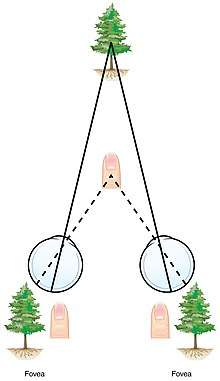Cyclopean image
Cyclopean image is a single mental image of a scene created by the brain through the process of combining two images received from both eyes. The mental process behind the Cyclopean image is crucial to stereo vision. Autostereograms take advantage of this process in order to trick the brain to form an apparent Cyclopean image from seemingly random patterns.

Cyclopean image is named after the mythical being, Cyclops, a creature possessing one single eye. The single refers to the way stereo sighted viewers perceive the center of their fused visual field as lying between the two physical eyes, as if seen by a cyclopean eye. Alternative terms for cyclopean eye include third central imaginary eye and binoculus.
The term cyclopean stimuli refers to a form of visual stimuli that is defined by binocular disparity alone. It was named after the one-eyed Cyclops of Homer’s Odyssey. The term cyclopean in the terms of binocular disparity was coined by Bela Julesz.[1] Julesz was a Hungarian radar engineer who predicted that stereopsis might help to discover hidden objects, which could prove useful in the finding of camouflaged objects. The important aspect of this research was that Julesz showed using random dot stereograms was sufficient for stereopsis, whereas Charles Wheatstone had only shown that binocular disparity was necessary for stereopsis.
There is a point of irony to the origin of the term cyclopean. The Cyclops from Homer's Odyssey would not have been able to see a cyclopean stimulus as he only possessed one eye. In order for stereopsis to occur, an individual must be able to make use of binocular depth cues, a skill the namesake of the term would not be able to utilize.
Binocular disparity as it relates to cyclopean images has become an interest in researchers[2] due to a rise in three dimensional technology use. This three dimensional technology exists not only in research settings but in entertainment industries as well.[3] Because cyclopean images are created using binocular depth cues, judging differences between two images on the retina, cyclopean images are important in understanding the surroundings of the individual. Research has shown that greater salience of an image lends to better extraction of important details from the Cyclopean image. It is also argued that a cyclopean image is extremely adaptive[4] based on the objects in space that our eyes see.
Proposed technology wishes to use the cyclopean image as a way to evaluate the quality of images used in search engines. Software currently exists today that allows a computer program to sift through images and deem them as low quality and high quality. Current research hopes to create a software that utilizes the same concepts our eyes use when evaluating an image. The idea behind these theories is that because a cyclopean image utilizes scene salience, an artificial intelligence could pull meaningful information from an image.[5]
References
- "Bela Julesz". www.nasonline.org. Retrieved 2020-06-29.
- Li, Sumei; Han, Xu; Chang, Yongli (October 2019). "Adaptive Cyclopean Image-Based Stereoscopic Image-Quality Assessment Using Ensemble Learning". IEEE Transactions on Multimedia. 21 (10): 2616–2624. doi:10.1109/TMM.2019.2907470. ISSN 1941-0077.
- Messai, Oussama; Hachouf, Fella; Seghir, Zianou Ahmed (2020-03-01). "AdaBoost neural network and cyclopean view for no-reference stereoscopic image quality assessment". Signal Processing: Image Communication. 82: 115772. doi:10.1016/j.image.2019.115772. ISSN 0923-5965.
- Li, Sumei; Han, Xu; Chang, Yongli (October 2019). "Adaptive Cyclopean Image-Based Stereoscopic Image-Quality Assessment Using Ensemble Learning". IEEE Transactions on Multimedia. 21 (10): 2616–2624. doi:10.1109/TMM.2019.2907470. ISSN 1941-0077.
- Yang, Jiachen; Sim, Kyohoon; Lu, Wen; Jiang, Bin (July 2019). "Predicting Stereoscopic Image Quality via Stacked Auto-Encoders Based on Stereopsis Formation". IEEE Transactions on Multimedia. 21 (7): 1750–1761. doi:10.1109/TMM.2018.2889562. ISSN 1941-0077.
- Julesz, B. (1971). Foundations of Cyclopean Perception. Chicago: The University of Chicago Press. ISBN 0-226-41527-9
- Julesz, B. (1971). Foundations of Cyclopean Perception. (2006) MIT Press. ISBN 0-262-10113-0
- Tyler, C.W. (1982). "Binocular Vision", Foundations of Clinical Ophthalmology (Chap 24)
- Pinker, S. (1997). The Mind's Eye. In How the Mind Works (pp. 211–233) ISBN 0-393-31848-6
- Henkel, R.D. (1997). Fast Stereovision by Coherence-Detection (pp. 297–304) ISBN 978-3-540-63460-7
- Tyler, C.W. (2005). "The Riches of the Cyclopean Paradigm", Human Vision and Electronic Imaging X; 5666, (pp. 62–70)
- Wolfe, J.M., Kluender, K.R., Levi, D.M., Bartoshuk, L.M., Herz, R.S., Klatzkey, R.L., & Lederman, S.J. (2006). Space Perception and Binocular Vision., Sensation & Perception